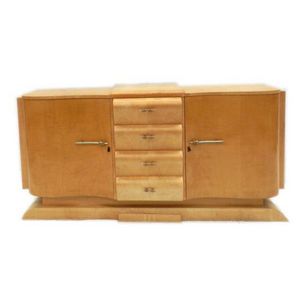Art Deco Sycamore Veneer Sideboard by Edward Hill, Melbourne
You must be a subscriber, and be logged in to view price and dealer details.
Subscribe Now to view actual auction price for this item
When you subscribe, you have the option of setting the currency in which to display prices to $Au, $US, $NZ or Stg.
- Art Deco Period - The Art Deco period was a cultural movement that emerged in the 1920s and 1930s, and was characterized by its emphasis on modernism, luxury, and elegance. The name "Art Deco" comes from the Exposition Internationale des Arts Décoratifs et Industriels Modernes, a large exhibition held in Paris in 1925 that showcased the latest trends in decorative arts.
Art Deco was a reaction against the ornate and elaborate styles of the previous era, and reflected a new modern sensibility. It was characterized by streamlined, geometric shapes, bright colours, and the use of new materials such as chrome, glass, and Bakelite. Art Deco designers sought to create a sense of luxury and sophistication, often incorporating expensive materials such as ivory, marble, and rare woods.
Art Deco had a significant impact on a wide range of artistic fields, including architecture, fashion, graphic design, and interior design. Some of the most iconic examples of Art Deco architecture include the Empire State Building in New York City, the Hoover Building in London, and the Palais de Chaillot in Paris.
The Art Deco period came to an end in the 1940s, as World War II and changing cultural trends led to a shift in artistic styles. However, Art Deco remains an important influence on design and art, and continues to be celebrated for its modernist sensibility and glamorous aesthetic. - Veneers - Veneers are thin sheets of well-figured timber that are glued under pressure to the surface of a cheaper timber for decorative effect, and then used in the making of carcase furniture.
Early veneers were saw-cut so were relatively thick, (up to 2 mm) but is was realised that saw cutting was wasteful, as timber to the equivilent of the thickness of the saw was lot on each cut.
A more efficient method was devised to slice the timber, either horizontally with a knife, or in a rotary lathe.
Flame veneer, commonly found in mahogany or cedar furniture, is cut from the junction of the branches and main trunk. So-called fiddleback veneers, where the grain is crossed by a series of pronounced darker lines, is usually cut from the outer sections of the tree trunk.
During the 17th and 18th centuries, and in much of the walnut marquetry furniture made during the latter part of the 19th century, the veneer was laid in quarters, each of the same grain, so that one half of the surface was the mirror image of the other.
The use of veneer allows many other decorative effects to be employed, including stringing, feather banding, cross banding, and inlaid decorative panels in the piece. The carcase over which veneer is laid is usually of cheaper timber such as pine, oak or, sometimes in Australia during the first half of the 19th century, red cedar.
The important thing to remember about veneers is that prior to about 1850 they were cut by hand, and were consequently quite thick - ranging up to about 2mm deep.
From the mid-19th century veneers were cut by machines and were almost wafer-thin. This is a critical point when trying to judge the approximate age of veneered furniture. - Bakelite - Bakelite was the first completely synthetic man-made substance. Bakelite was invented in 1909 by an independent New York chemist Leo H. Baekeland. It was called the "material of a thousand uses" and used to make everything from car parts to jewellery.
Although nearly all plastic from this period is known as ?Bakelite', it is important to remember that this is an umbrella term that covers many different early plastics such as Lucite and cellulose acetate, and includes Bakelite.
We often think of the colour of Bakelite items as dark brown, but it was manufactured in various colours including yellow, butterscotch, red, green and brown.
Bakelite could also be transparent, or marbleised by mixing two colours. Plastics were cheap to produce and could be moulded or carved in a huge variety of ways.
Bakelite is most commonly associated with radio cases of the 1930s, telephones and kitchen utensils, but it was also used extensively in jewellery manufacture.
Early designs from the 1920s were plainer and simpler than later examples. Geometric and floral patterns typical of Art Deco styling were popular.
During its heyday in the 1930s, Bakelite jewellery was stocked by the most prestigious stores, such as Saks, Harrods and Macy?s, who dedicated a shop window display to it in 1935.
Coco Chanel featured Bakelite items in her accessories collection and the material was praised frequently in Vogue magazine.
Manufacture of some consumer Items were suspended in 1942 in order to concentrate manufacturing on the war effort.
Small items made of Bakelite are now valuable collectables. Andy Warhol was an avid collector, and when he died in 1987, his pieces sold for record prices at Sotheby's.
This item has been included into following indexes:
Visually similar items

Pair Victorian sterling silver berry spoons, London 1890, makers Josiah Williams & Co, (marked on 1 spoon), gilt washed bowls, with embossed rose decoration. Weight 148grams (total)

Three 24ct gold USA Bank notes

Chinese blue and white porcelain vase, of facetted form, decorated with panels of vases and stands, surrounded by shou motifs, seal mark to base, height 42 cm

A whalebone baleen and carved wood cane, 19th century, turned ridded fish scale and spiral carved, 83 cm long
